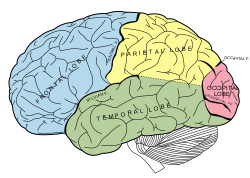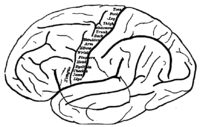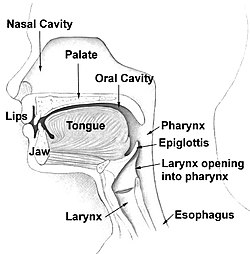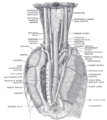A human brain showing
frontotemporal lobar degeneration causing frontotemporal dementia
Clinically, death is defined as an absence of brain activity as measured by EEG. Injuries to the brain tend to affect large areas of the organ, sometimes causing major deficits in intelligence, memory, and movement. Head trauma caused, for example, by vehicle or industrial accidents, is a leading cause of death in youth and middle age. In many cases, more damage is caused by resultant edema than by the impact itself. Stroke, caused by the blockage or rupturing of blood vessels in the brain, is another major cause of death from brain damage.
Other problems in the brain can be more accurately classified as diseases than as injuries. Neurodegenerative diseases, such as Alzheimer's disease, Parkinson's disease, motor neurone disease, and Huntington's disease are caused by the gradual death of individual neurons, leading to diminution in movement control, memory, and cognition.
Mental disorders, such as clinical depression, schizophrenia, bipolar disorder and post-traumatic stress disorder may involve particular patterns of neuropsychological functioning related to various aspects of mental and somatic function. These disorders may be treated by psychotherapy, psychiatric medication or social intervention and personal recovery work; the underlying issues and associated prognosis vary significantly between individuals.
Some infectious diseases affecting the brain are caused by viruses and bacteria. Infection of the meninges, the membrane that covers the brain, can lead to meningitis. Bovine spongiform encephalopathy (also known as "mad cow disease") is deadly in cattle and humans and is linked to prions. Kuru is a similar prion-borne degenerative brain disease affecting humans. Both are linked to the ingestion of neural tissue, and may explain the tendency in human and some non-human species to avoid cannibalism. Viral or bacterial causes have been reported in multiple sclerosis and Parkinson's disease, and are established causes of encephalopathy, and encephalomyelitis.
Many brain disorders are congenital, occurring during development. Tay-Sachs disease, Fragile X syndrome, and Down syndrome are all linked to genetic and chromosomal errors. Many other syndromes, such as the intrinsic circadian rhythm disorders, are suspected to be congenital as well. Normal development of the brain can be altered by genetic factors, drug use, nutritional deficiencies, and infectious diseases during pregnancy.

Location of two brain areas that play a critical role in language,
Broca's area and
Wernicke's areaIn human beings, it is the left hemisphere that usually contains the specialized language areas. While this holds true for 97% of right-handed people, about 19% of left-handed people have their language areas in the right hemisphere and as many as 68% of them have some language abilities in both the left and the right hemisphere. The two hemispheres are thought to contribute to the processing and understanding of language: the left hemisphere processes the linguistic meaning of prosody (or, the rhythm, stress, and intonation of connected speech), while the right hemisphere processes the emotions conveyed by prosody.[12] Studies of children have shown that if a child has damage to the left hemisphere, the child may develop language in the right hemisphere instead. The younger the child, the better the recovery. So, although the "natural" tendency is for language to develop on the left, human brains are capable of adapting to difficult circumstances, if the damage occurs early enough.
The first language area within the left hemisphere to be discovered is Broca's area, named after Paul Broca, who discovered the area while studying patients with aphasia, a language disorder. Broca's area doesn't just handle getting language out in a motor sense, though. It seems to be more generally involved in the ability to process grammar itself, at least the more complex aspects of grammar. For example, it handles distinguishing a sentence in passive form from a simpler subject-verb-object sentence — the difference between "The boy was hit by the girl" and "The boy hit the girl."
The second language area to be discovered is called Wernicke's area, after Carl Wernicke, a German neurologist who discovered the area while studying patients who had similar symptoms to Broca's area patients but damage to a different part of their brain. Wernicke's aphasia is the term for the disorder occurring upon damage to a patient's Wernicke's area.
Wernicke's aphasia does not only affect speech comprehension. People with Wernicke's aphasia also have difficulty recalling the names of objects, often responding with words that sound similar, or the names of related things, as if they are having a hard time recalling word associations[citation needed].































